全链游戏时代正在到来:未来的10个趋势
https://www.theblockbeats.info/news/34968
-
沉浸式体验源于链上游戏的持久性;
-
拥抱开放、协作和适应性更强的网络;
-
游戏内容未来将围绕着公共领域的 NFT;
-
经济超结构将从开放经济中出现;
-
协议 DAO 释放了社区所有权的力量;
-
公会 DAO 是这场无需信任革命的新领域;
-
游戏是广义治理原语的试验场;
-
链下社交层增加了深度、复杂性和吸引力;
-
游戏间 Token 将出现,代表「游戏工作证明」;
-
创新的游戏玩法通过资产收益和流派重叠循环。
Web3 游戏最大的优势则在于它们的开源代码、自下而上的开发、可组合性、信任最小化和无许可的特性,以及持久性。
它们提供了高度的反脆弱性,有可能在以太坊网络(或其他网络)的生命周期内持续存在。此外,区块链上透明且不可更改的游戏内交互记录提高了信任度和问责制,消除了审查和操纵的风险。
不过,这类游戏在 UX/UI、延迟和信息隐藏方面仍面临着挑战,使它们容易受到反向运行和其他形式的 MEV 的影响。
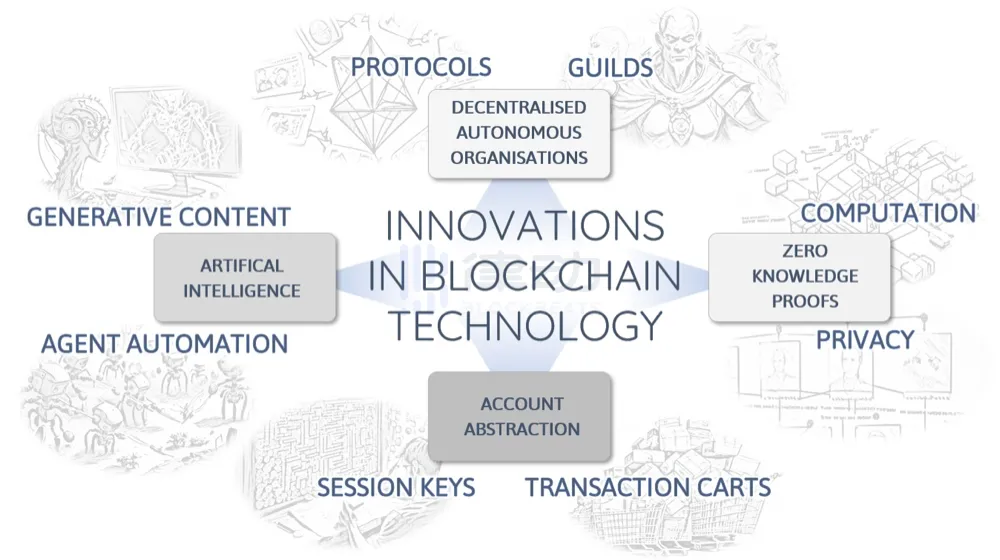
目前,我们正处于一场游戏革命的风口浪尖,这场革命的重要性甚至能与游戏机、手机游戏等的进步相匹配。
本文由 简悦 SimpRead 转码, 原文地址 medium.com
Blockchain technologies are maturing and it is dramatically transforming the gaming landscape. Glimme......
Blockchain technologies are maturing and it is dramatically transforming the gaming landscape. Glimmers of novel gaming experiences are emerging, so it’s no surprise that attention is swelling around on-chain games. They’re as revolutionary as arcades, consoles and mobile.
Offering a new era of immersive and persistent gaming, they have the potential to endure for generations. While they present unique challenges, they also provide a more equitable and transparent gaming experience for all players.
On-chain games will result in dynamic, vibrant, and constantly evolving ecosystems that foster community and collaboration. With open-source code and permissionless custom clients and mods, these games are a democratising force within the gaming industry. They are not just about playing, but about community ownership and governance. By leveraging the power of decentralised networks, they can unlock the full potential of player and developer communities.
In this article I cover the 10 most compelling trends and differentiating factors that make pure on-chain games so exciting:
- Immersive experience due to longevity and persistence.
- Successes will embrace open, collaborative, and adaptable networks.
- The future of in-game content revolves around public domain NFTs.
- Economic hyperstructures will emerge from open economies.
- DAOs as Protocols unleash the power of community ownership.
- DAOs as Guilds are a new frontier in this trustless revolution.
- Games are the testing ground for generalised governance primitives.
- Off-chain social layers add depth, complexity and intrigue.
- Inter-game tokens will emerge representing “Proof of Gaming Work”.
- Innovative gameplay loops through asset yields and genre overlap.
Before going into detail on the above it is essential to define exactly what a pure on-chain game means, because when it comes to blockchain based games, they exist on a spectrum of “on-chainess”. There are three broad categories:
WEB 2.0+ GAMES:
Weakly on-chain games offer players a seamless and accessible gaming experience. Their key advantages include ease of scaling, public accessibility, superior UX, low latency, and efficient bug-fixing processes.
Traditionally games are walled gardens in which the benefactor of continued use and in game purchases is solely the game developer. The key breakthrough was enabling players’ sovereignty over their in-game assets, removing the need for intermediaries to act as gatekeepers.
However, these games have their drawbacks. They carry a high risk of centralization, relying on closed-source code and placing trust in the hands of a single game publisher. Additionally, weak composability and non-persistence pose challenges to players looking for a truly decentralised gaming experience.
WEB 2.5 GAMES:
Ushered in the era of play-2-earn (P2E), a breakout area with very high DAUs in 2021. However the reality is that many P2E games weren’t fun to play. They were merely financial ideas over which a veiled game was thinly overlayed to try and attract users. The processes for determining rewards remained opaque and confusing, creating a lack of transparency which bred mistrust among players.
Unfortunately a layer of speculators existed who invested external money to cash it out when the game was successful. This led to an efflux of value from the system, causing negative price pressures on the value of assets and indirectly extracting the rewards that typically go to the players. Users evaporated.
Furthermore, earlier iterations faced criticism for their failure to balance rewards with gameplay difficulty. They have lacked adaptability, creating a pay-to-win mentality where players felt that they needed to spend money to be competitive, discouraging those who did not want to spend money.
WEB 3 GAMES:
Their greatest strengths lie in their open-source code, bottom-up development, composability, trust-minimised and permissionless nature, and persistence.
They offer a high degree of antifragility, with the potential to endure for the lifetime of the Ethereum network (or others). In addition, trust and accountability are elevated by the transparent and immutable recording of in-game interactions on the blockchain, eliminating the risk of censorship and manipulation.
However, these games also face challenges in UX/UI, latency and information hiding, leaving them vulnerable to back-running and other forms of MEV.
Innovations in blockchain technology are unleashing new functionality, and stimulating the development of pure web3 games. Zero-knowledge proof (ZKP) technology can protect sensitive information while allowing for complex mechanics and interactions. Optimistic Rollups can enhance the scalability and performance of on-chain games, enabling developers to create rich and dynamic player experiences.
DAOs (decentralised autonomous organisations) are operating at both a protocol and guild level to help coordinate activity and collaboration. Furthermore, account abstraction has drastically enhanced UI and UX making experiences much more approachable for the average player.
Finally, AI produces generative and procedural output and automate in-game agents to create rich and vibrant worlds.
It’s taken some time for these cutting-edge technologies to reach a level of sophistication to enable a radical overhaul of the gaming experience. Finally, we are on the cusp of a gaming revolution that will match the advances of consoles and mobile games.
So lets now dig in to those 10 trends that are enabled by these technological innovations:
1 — The Longevity and Persistence of On-Chain Games: A New Era of Immersive Gaming
Autonomous worlds, or eternal games, offer a new level of immersion and interactivity, partly due to their longevity and persistent environments. With all game logic and game state recorded on-chain, once deployed, they are permanent, ensuring that they will be playable as long as the chain is around. These games can theoretically go on for generations, making them more investable from both a time and capital perspective.
In this way, eternal games will be potentially unsolvable with continuously non-trivial gameplay as an attribute i.e. “infinite puzzles.” If all else fails, and a game breaks, or the developers leave, yet there is still demand for the game, forkability can ensure that the games persist.
“Eras” will exist, and be chronicled within game lore, where maps or resources are dominated for extensive periods by super-users and guilds. However, the balance of power will invariably shift, as those who govern the protocol (and therefore its value) are incentivised to keep the game exciting and fun for old and new players alike.
To see the complete game history, an item’s history and even that of a player will provide a level of provenance that can reward long-term contributors to the game in myriad yet-to-be-explored ways.
Persistent, on-chain games offer enhanced interactivity, as their time based and “always-on” nature require a degree of coordination amongst other players with shared incentives and alignment, encouraging worldwide and borderless guilds. This can connect people meaningfully and create a global community around the game.
2 — Open Collaboration: Adaptable Networks That Can Capture Opportunity
With open-source code and a permissionless structure, players can customise and modify the games they love, becoming player-creators who are not only invested in the success of the game but also passionate advocates of it. This shift from passive consumption to active creation leads to unparalleled creativity, community building, and growth.
On the one hand they are not limited by the resources of a single studio. On the other hand, small budgets and the use of time as a commodity level the playing field, providing an accessible platform for indie game developers and passion projects.
Composability creates a fascinating design space. Games designers are already building with this principle in mind; MUD leverages an “Entity Component System” on the Optimism L2, with other teams building similar architectures on ZK L2s. These implementations will allow developers to create reusable and modular components that can be easily combined to create new games and game entities, increasing performance, scalability and flexibility.
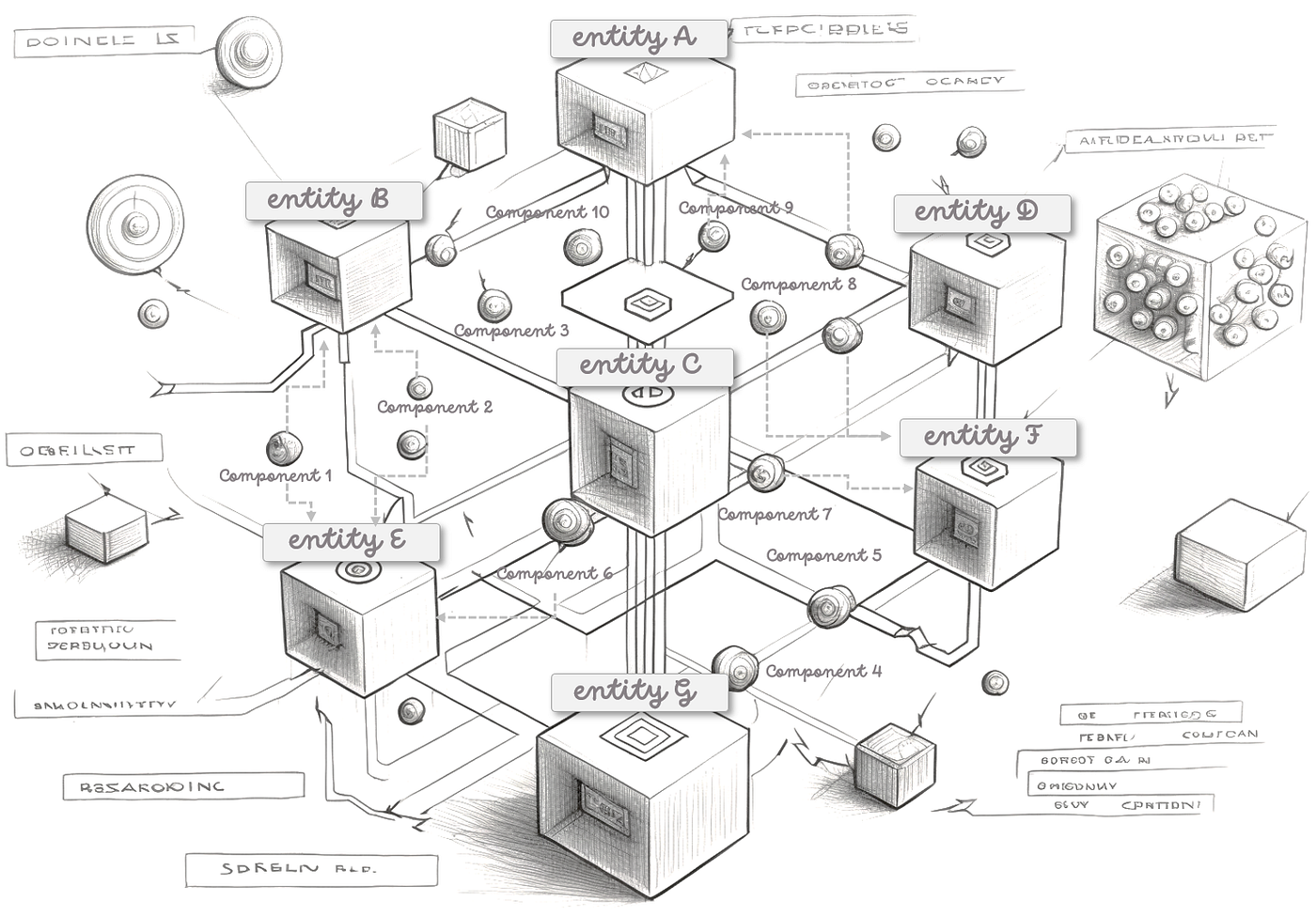
True ownership and the ability to apply royalties creates opportunities for content creation. The combination of AI-generated and user-generated content generates diverse and imaginative gaming environments, spinning up vast games and worlds in rapid time.
The democratisation of the game development process will also reduce costs and increase innovation potential. Moreover, their open nature means that players can contribute not just to the core game but to all sorts of things around the periphery.
External builders will contribute layers on top of what already exists. For example, they can reward players for previous actions (as recorded on-chain), construct new communities around particular achievements or aspects of the game, and create novel gameplay loops to reward certain player types. This will create stickiness and attention that mimics “seasons” in traditional games.
3 — Unleashing the Potential of Public Domain NFTs: The Future of In-Game Content
The world of in-game content is undergoing a significant transformation, with the advent of non-fungible tokens (NFTs). One of the key drivers of this change is the adoption of CC0 (Creative Commons Zero) licences, which allow NFT creators to dedicate their work to the public domain, enabling reuse and distribution without legal restrictions. This bottom-up approach to development creates a more open and creative ecosystem, fostering a flywheel effect that drives innovation and growth.
Credit: tandavas.eth
This concept first emerged in Loot, created by Dom Hofmann, from which the “lootverse” has emerged, including projects such as Realms, Crypts & Caverns, Genesis Adventurers, Banners, Hyperloot as well as many others built on top of it.
This is because NFTs created under a CC0 licence can be easily shared, modified, and remixed, and their modular structure supports the creation of initial primitives that can be combined and treated as a single asset through “on-chain bundling.” This bundling increases flexibility and opens up new possibilities within NFT universes, allowing for greater detail and user engagement.
Procedural generation (ProcGen), as written about by 0xParc, is also playing a crucial role in the growth of in-game content in on-chain games. This powerful tool automates content creation using algorithms like cellular automata, fractals, and Markov chains, as seen in on-chain generative art. However, it will soon extend into the realm of games, and used to create large, diverse, and complex environments thus making games more interesting and replayable.
4 — Economic Hyperstructures: Emerging out of Open Economies
Open economies in on-chain games offer a unique and compelling gaming experience that rivals traditional games. These economies, notable examples of which include Mithraeum and Realms:Eternum, may even span multiple games. They result in player-driven experiences where demand for in-game assets, items, and skills determines their value. This creates an environment where players must think critically and act strategically, leading to a more engaging and satisfying gaming experience.
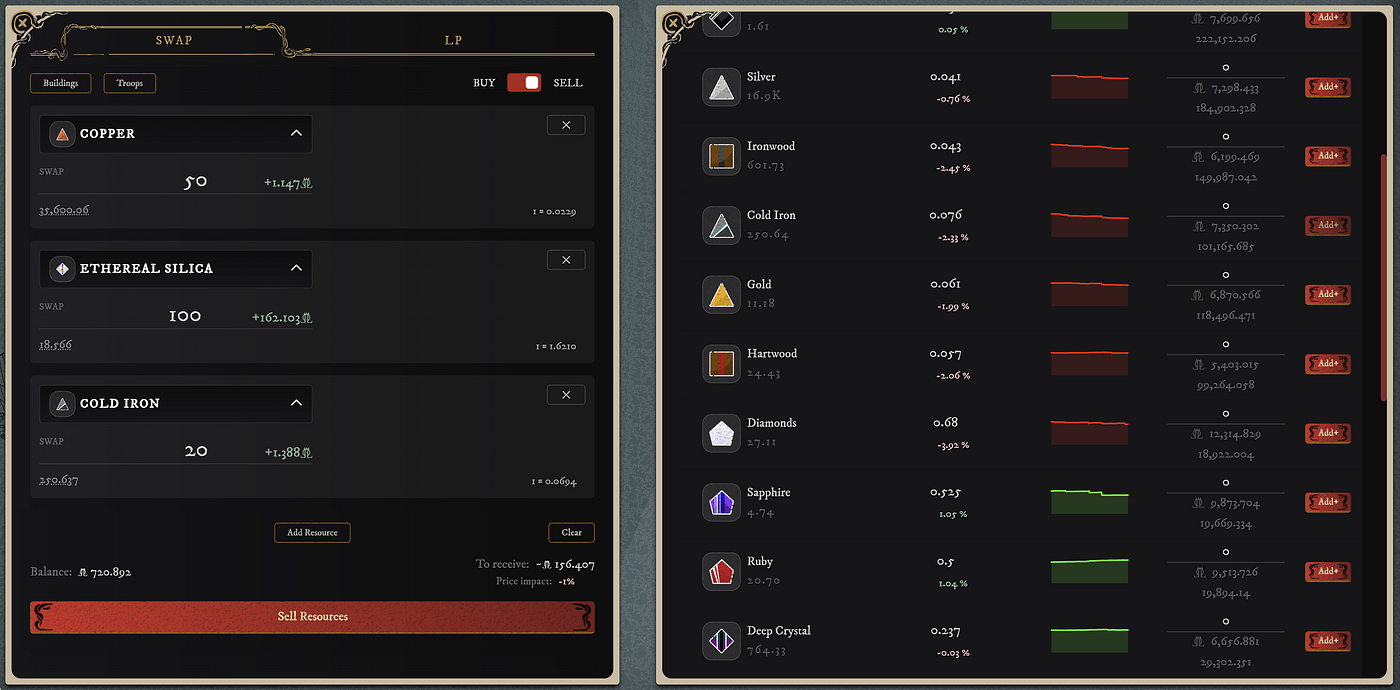 Realms:Eternum Resource Bazaar
Realms:Eternum Resource Bazaar
Market inefficiencies and arbitrage opportunities in open economies give enterprising players a chance to profit and foster competition and innovation. For popular games we will no doubt see derivatives of resources be created. The interplay of supply, demand, and market forces interact to determine prices and influence how players allocate resources. Blockchain technology is critical in ensuring that game economies operate efficiently and that players have the freedom to make choices and engage in trade transparently and fairly.
The aforementioned “on-chain bundling,” where multiple NFTs are combined to create a more valuable asset will become a key component of open economies . It allows for greater flexibility and opens up new possibilities. Furthermore, the interplay of skin-in-the-game, true ownership, and on-chain bundling mechanics creates a virtuous cycle of player investment, enjoyment, and reward, leading to increased engagement and player retention.
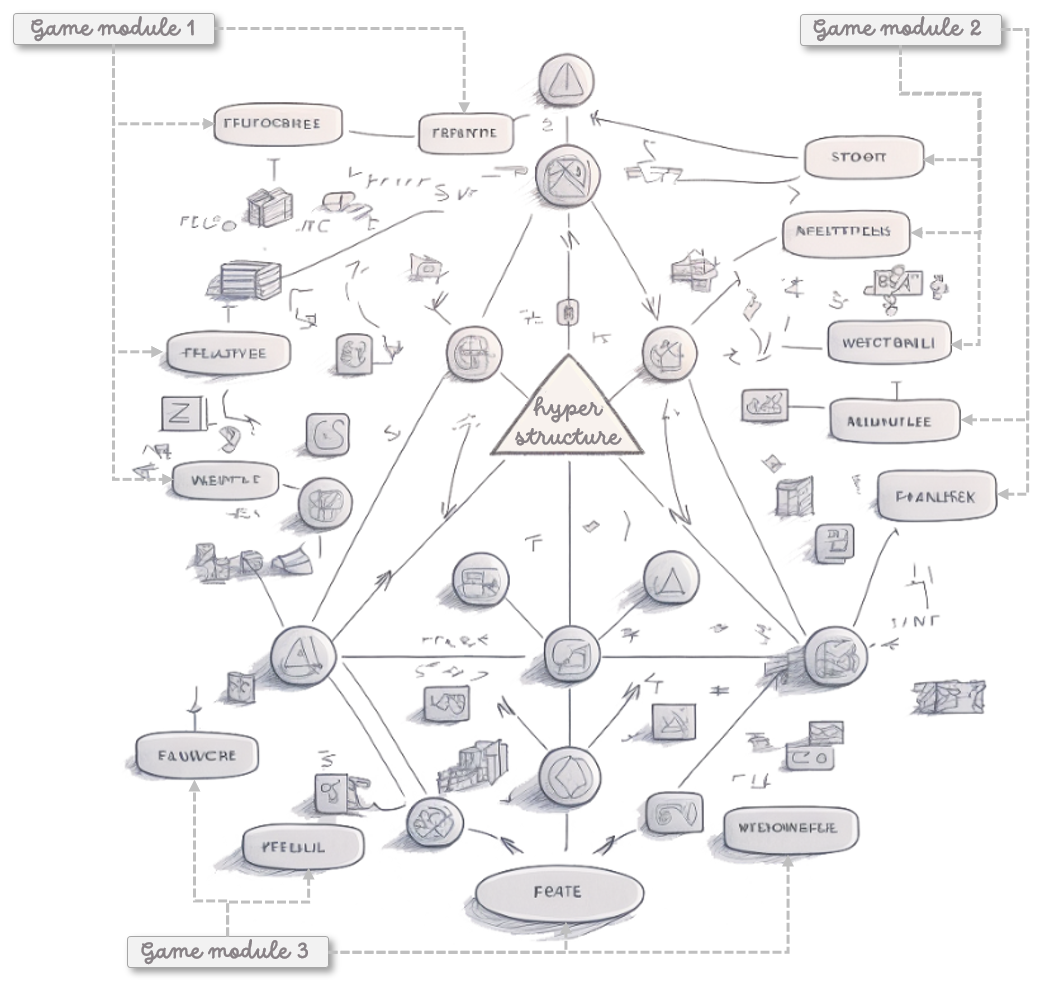
Economic hyperstructures, as illustrated above, will be shaped by the intricate and interdependent relationships between individuals, assets, NFT bundles, and other various smart contracts, drawn together by the synergies they generate. Autonomous agents will harvest these economic hyperstructures for players and guilds, adding another layer of complexity to in-game economics. These will likely be the first notable PvA (player vs. A.I.) battlegrounds.
5 — Unleashing the Power of Community: Ownership, Governance and Raising Capital
Unlike traditional web2 games, Web3 games eliminate central control and potential manipulation, offering full audibility, transparency, and accountability. This newfound freedom has profound implications for player rewards, game dynamics, and governance.
The sovereignty and private property rights inherent in decentralised networks encourage players to engage in the market and contribute to the economy’s overall health.
Controlling the game’s parameters, such as physics variables, resource emissions, battle outcomes, rewards systems, and developer incentives, are all examples of on-chain game governance. However, creating self-sustaining economies is a challenge, which makes these types of governance especially critical.
The decentralisation of on-chain games means that the rules are transparent and immutable, making them less prone to exploitation. Within the game, this translates into a fairer and more level playing field, where success is determined by skill, effort, and luck, rather than insider knowledge or connections.
Protocol DAOs, such as BibliothecaDAO (of Realms:Eternum), are responsible for developing these games — building and maintaining repositories of gaming utilities and components. DAOs will be recognised as a great instrument to harness the collective creativity of the player and developer communities.
Their governance tokens control their ability to issue protocol tokens as rewards for contributions to the game, and rewards for player-generated content. This dispersion fosters a sense of ownership and investment in the game, whilst simultaneously providing a unique experience compared to traditional centralised gaming models. Consequently, it improves interest and engagement, encourages promotion and drives growth.
These protocols are independent of the mercenary and vapid capital of VCs. Instead, they can lean back into their communities and stakeholders when wanting to raise funds. This has been exemplified by AavegotchiDAO, and more recently by the team behind Realms:Eternum which was 6.4x oversubscribed.
The on-chain nature of these games also provides valuable insights into player behaviour and game dynamics, helping game developers create engaging games and better understand player behaviour.
As well as protocol DAOs, ecosystem DAOs such as MatchBox can issue bounties and launch hackathons, further strengthening communities by unlocking their potential and fostering teamwork. They have published significant content regarding blockchain game concepts, tools, and ideas, and will continue to provide mentorship for aspiring game developers far into the future.
6 — The Trustless Revolution: Navigating the New Frontier of DAOs as Guilds
In the world of on-chain games, trustless guilds are emerging as game-changers by eliminating central control and potential manipulation, which plagues traditional web2 games. By leveraging DAOs and smart contracts they allow entities and individuals to work together, delegate activities, and share revenue, reducing barriers and eliminating the need for trust.
Guilds and guild platforms, like Guildly, are leveraging new developments in account abstraction. Beyond the obvious advantages of easier onboarding of players, this technology enables the pooling of assets as well as splitting control responsibilities over those assets. Implementing traditional DeFi mechanics in on-chain gaming has opened up a whole new market for lending and borrowing of yield-generating assets and DAO-2-DAOs agreements are emerging. For example, DAOs that sit on the supply side of these games, collecting and “breeding” in-game assets, such as DarkHorse can earn a yield by leveraging DAOs on the demand side of these games such as ReadyPlayer which have an army of scholars.
Assets are leant out in return for a share of the scholar’s earnings while they use the assets in game. These revenue sharing agreements create an environment of mutually beneficial value generation.
Smart contracts and automation facilitate coordination between players and assets, systematising actions and reducing barriers to entry. This coordination blurs the line between developers and players, fostering a community-driven economy that encourages cooperative asset management and collaboration.
A deeper social connection develops among players as they earn, combine assets, and work together, leading to increased engagement and player retention.
7 — Building a Better Future: The Emergence of Generalised Governance Primitives
These games will serve as a testing ground for various governance primitives, including economic, defensive, and offensive agreements; a safer proving ground than the real world. In addition, we can figure out novel and appropriate ways to use emerging technologies like zk-proofs. And because of the open economies within the games, these very well may have real world future applications.
Initially, these primitives were formed in guild DAOs, but their scope has now expanded to include all DAOs, even non-gaming ones. A set of primitives are emerging that are composable in nature and can be combined like Lego blocks. For example the early primitive OfferProtocol:
Credit: Bohdan Melnychuck
These schemas encompass anything from simple token/NFT swaps to complex social agreements. Furthermore, they won’t be specific to one game, but instead shared across multiple, as well as being adopted by DAOs outside of the gaming industry. It is with account abstraction that they will realise their full power.
The flexibility of these primitives is what makes them so appealing. For example, as described by Bohdan Melnychuck, the Mithraeum Founder, shares in assets can be issued and offered as part of negotiations for alliances and vassalage. The ability to negotiate, trade and lend out entire or fractionalised assets within these games is a significant development, and one that can change how we think about ownership and property rights.
The emergence of these primitives in other 4x grand strategy games beyond Mithraeum, such as Treaty, is a testament to the power of on-chain contracts. The games provide a safe space for experimentation and bundling, and as a result, are helping to shape the future of decentralised governance.
8 — Navigating the Social Layers of On-Chain Games: Exploring the Intersection of Cooperation and Competition
Off-chain social layers will augment the vanilla on-chain gaming experience. These layers are separate from the inner workings of the games, but they significantly impact how players interact and cooperate with each other.
Humans are inherently unpredictable, adding a level of strategy to the games that makes them challenging. Intel collection and sharing, from on-chain sleuthing (to see how resources are allocated and armies are recruited), to counter-espionage (establishing connections between unlinked addresses) are just a few examples of the tactics used by players.
Despite the perception that these games are simply DeFi in gaming clothing, individuals’ complex and interdependent interactions give rise to a dynamic and sometimes chaotic environment that requires an adaptable approach. As a result, these games will not be easily botted, and players must rely on their social skills and strategic thinking to succeed.
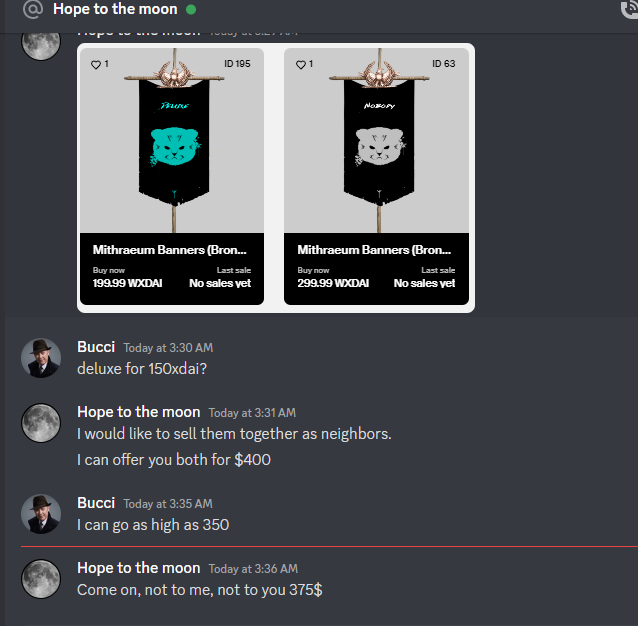 An OTC deal for two Mithraeum settlements being negotiated in discord.
An OTC deal for two Mithraeum settlements being negotiated in discord.
Over the counter negotiations, on-chain espionage, transparent on-chain interactions, and privacy technologies all play a role in shaping the social landscape of these games. Coordination across multiple mediums is increasingly becoming the norm, and it remains to be seen if a single uniformed space will emerge.
9 — The Rise of PoGW Tokens: Allowing Gamers to Transmit Value Across Different Gaming Universes.
Gamers invest significant time and energy into building up their in-game characters, acquiring weapons, and obtaining upgrades. This “Proof of Gaming Work” (PoGW) is a testament to their dedication and hard work within a gaming universe. However, the inability to transfer this value to other games makes it challenging to monetise these achievements.
The concept of transferable PoGW tokens could revolutionise the gaming industry by allowing for the transfer of value between gaming universes. Rather than focusing on asset portability, this new model emphasises interoperability and universal reputation. After all, a medieval sword from one game is less than helpful (and therefore valuable) in the trenches of a WW1 game. Likewise, a seasoned racecar driver wouldn’t stand a chance against a dragon set on destroying a small fantasy world village.
One example of this new approach is TreasureDAO, a community-oriented gaming network governed by its native token, MAGIC**](https://docs.treasure.lol/getting-started/what-is-magic). MAGIC also serves as a PoGW token and is the in-game currency for all games within the TreasureDAO ecosystem. Players can purchase or earn MAGIC through staking and gameplay or acquire it by selling characters and in-game items. Another example is [**LORDS, the token of the Realms ecosystem.
This new model is not only beneficial to gamers, via monetisation of their attention, but it also promotes community engagement and creativity. Players can trade their PoGW tokens with other players or even use them as a form of payment for goods and services.
Ultimately, on-chain inter-game tokens offer players greater autonomy and control over their in-game achievements. Instead of being locked into a single gaming universe, players can take their accomplishments wherever they go. This creates a sense of ownership and personal investment in their gaming experience, leading to increased engagement and enjoyment.
10 — Blockchain Limitations Result in Innovative Gameplay Loops: Genre Overlap, Obfuscated Information and Metagaming.
Within these persistent universes, all state and logic are on-chain, allowing for the modular construction of games of different genres within the same universe. For example, within a space pirate game where players compete to mine asteroids against each other and intercept and attack each other for booty, a builder could create an entirely new game on top that features silicon or energy-based life forms to target the pirates and therefore a completely novel player-vs-environment experience.
However, this technology also opens up new possibilities for cross-genre gaming experiences that can bring together formerly separate communities. BibliothecaDAO, a leading platform in blockchain gaming, is taking this concept to the next level with its 4x grand strategy game, Realms:Eternum, crossed with a DnD-type role-playing game, Realms:Adventurers. This marks the first time these two genres have intersected within a gaming universe, precipitating the collision of two distinct gamer groups like never before.
By bringing together these previously separate gaming communities, novel gameplay loops emerge where both communities can provide resources/items/etc. for each other. For example, Adventurers can craft items that act as boosts for the buildings in Eternum, and Eternum landowners can create questing opportunities for the adventurers to win resources they can use for the aforementioned crafting.
ZKP technology will provide an innovative solution for resolving problems around on-chain transparency. It will allow for gameplay loops where players can use their hidden information to gain a strategic advantage, while also ensuring the integrity of the game. ZKP can also prove ownership of a digital asset without revealing the asset itself, providing greater privacy for players.
A previous section discussed the social layers of on-chain games. Metagaming is a term used to describe games played outside of the direct game itself; the social-diplomatic layer is a form of metagaming. Players can only play the base game successfully by paying attention to this crucial layer — even more critical in on-chain games, especially when real money is at stake.
Pureplay on-chain games represent a bold and exciting step forward in the world of gaming. Their unique characteristics offer an unparalleled gaming experience that is both challenging and rewarding, and they are poised to shape the future of gaming as we know it. However, change is only successfully adopted or necessary when the successor visibly improves aspects of the legacy infrastructure and dynamics. Many best-fit blockchain implementations have emerged by following a common trend, enabling processes that could not have been done (or done better) without it, ultimately benefiting the users — in this case, the gamers.
Pureplay On-chain gaming is one such implementation:
- By incorporating community feedback and input, on-chain games are truly community-driven and adaptable, with the ability to create an almost limitless range of games, from casual diversions to complex virtual worlds that may last for generations.
- The combination of CC0 and AI enables the generation of infinite autonomous content; the possibilities for players, developers, and game designers are limitless.
- On-chain in-game currencies allow players to transfer value between gaming universes, promoting community engagement, creativity, and investment opportunities in open economies that will, in some cases, lead to economic hyperstructures. Conversely, on-chain games also create new opportunities for cross-genre experiences within the same gaming universes, bringing together formerly separate communities.
- Nascent social layers mean these games are more than just entertainment; they are a new frontier for social interaction and collaboration. This collaboration will be scaled and organised in trustless guilds and DAOs.
- The evolution of generalised governance primitives in on-chain games is a story of innovation, experimentation, and growth. These games serve as a proving ground for developing new governance models, and their impact is only beginning to be felt. As the technology and understanding of these primitives evolve, we can expect to see their influence spread beyond gaming and into the broader realm of DAOs.
The main challenge for game developers is to avoid the pitfalls of pay-to-win dynamics, where players with more resources have an advantage over others. Instead, open economies in on-chain games must strike a balance between investment and reward, creating a fair and transparent playing field for all players. With careful planning and design, the open economies of on-chain games promise to offer a truly immersive and engaging gaming experience.
Ultimately, gamers have greater autonomy and control over their in-game achievements. In addition, they can now monetise their investment into each game and leverage value creation from many previously unrelated communities, leading to a more satisfying and rich gaming experience.
The future of on-chain games is bright, and we are only just scratching the surface of what can be achieved
Thanks to Bohdan, Loaf, ChrisF, Sonofwolf, Timshel, JackM, Heeeeeeeeee, and members of Flamingo, Neon, Readyplayer, and Darkhorse DAOs and of course my colleagues at ID Theory for the amazing conversations that helped me craft this thesis over the last 18 months. A special thanks to Charlie Edwards for reviewing and providing critical feedback on this document.
ID Theory may hold positions in some of the assets discussed in this post. This post is strictly for informational and educational purposes only. It does not in any way constitute an offer or solicitation of an offer to buy or sell any investment or cryptoassets discussed herein. Always perform your own research and conduct independent due diligence prior to making any investment decisions.
Interested in partnering with ID Theory or building something special? Get in touch through our website or at [email protected].